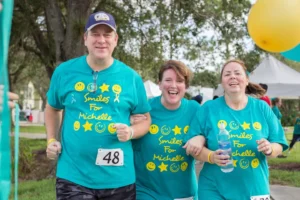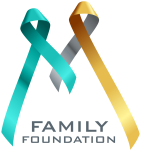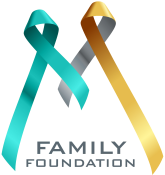Ovarian Cancer
Learn more about ovarian cancer, including risk factors, symptoms, how it is found, and treated.
About Ovarian Cancer
If you have ovarian cancer or are close to someone who does, knowing what to expect can help you cope.
Cancer starts when cells in the body begin to grow out of control. Cells in nearly any part of the body can become cancer and spread.
Ovarian cancers were previously believed to begin only in the ovaries. Still, recent evidence suggests that many ovarian cancers may start in the cells in the far (distal) end of the fallopian tubes.
The ovaries are mainly made up of 3 kinds of cells. Each type of cell can develop into a different type of tumor. Some of these tumors are benign (non-cancerous) and never spread beyond the ovary. Malignant (cancerous) or borderline (low malignant potential) ovarian tumors can spread (metastasize) to other parts of the body and can be fatal.


Frequently asked questions.
You have questions, we have answers.
We don’t yet know precisely what causes most ovarian cancers. We know some factors that make a woman more likely to develop epithelial ovarian cancer. Much less is known about risk factors for germ cell and stromal tumors of the ovaries.
The most recent and essential finding about the cause of ovarian cancer is that it starts in cells at the tail ends of the fallopian tubes and not necessarily in the ovary itself. This new information may open more research studies to prevent and screen for this type of cancer.
There are many theories about the causes of ovarian cancer. Some of them came from looking at the things that change the risk of ovarian cancer. For example, pregnancy and taking birth control pills to lower the risk of ovarian cancer. Since both of these things reduce the number of times the ovary releases an egg (ovulation), some researchers think there may be some relationship between ovulation and the risk of developing ovarian cancer.
Also, we know that tubal ligation and hysterectomy lower the risk of ovarian cancer. One theory to explain this is that some cancer-causing substances may enter the body through the vagina and pass through the uterus and fallopian tubes to reach the ovaries. This would explain how removing the uterus or blocking the fallopian tubes affects ovarian cancer risk.
Another theory is that male hormones (androgens) can cause ovarian cancer.
A risk factor is anything that increases your chance of getting a disease like cancer. Some risk factors, like smoking, can be changed. Others, like a person’s age or family history, can’t be changed. Listed below are all risk factors:
- Getting older
- Being overweight or obese
- Having children later or never having a full-term pregnancy
- Taking hormone therapy after menopause
- Having a family history of ovarian cancer, breast cancer, or colorectal cancer
- Having a family cancer syndrome
You can reduce your risk of developing the most common type of ovarian cancer, epithelial ovarian cancer. Much less is known about ways to lower the risk of developing germ cell and stromal tumors of the ovaries, so this information does not apply to those types. It is essential to realize that some of these strategies only lower your risk slightly, while others reduce it. Some plans are easily followed, and others require surgery. If you are concerned about your risk of ovarian cancer, talk to your health care professionals. They can help you consider these ideas as they apply to your situation.
- Oral contraceptives (birth control pills) decreases the risk of developing ovarian cancer for average-risk women and BRCA mutation carriers, especially among women who have used them for several years.
- Gynecologic surgery – Both tubal ligation and hysterectomy may reduce the chance of developing certain types of ovarian cancer, but experts agree that these operations should only be done for valid medical reasons — not for their effect on ovarian cancer risk.
- Prevention strategies for women with a family history of ovarian cancer or BRCA mutation – If your family history suggests that you (or a close relative) might have a syndrome linked with a high risk of ovarian cancer, you might consider genetic counseling and testing.
Ovarian cancer may cause several signs and symptoms. Women are more likely to have symptoms of the disease has spread, but even early-stage ovarian cancer can cause them. The most common symptoms include:
- Bloating
- Pelvic or abdominal (belly) pain
- Trouble eating or feeling full quickly
- Urinary symptoms such as urgency (constantly feeling like you have to go) or frequency (having to go often)
These symptoms are also commonly caused by benign (non-cancerous) diseases and by cancers of other organs. When they are caused by ovarian cancer, they tend to be persistent and a change from normal − for example, they occur more often or are more severe. These symptoms are more likely to be caused by other conditions, and most of them occur just about as often in women who don’t have ovarian cancer. But if you have these symptoms more than 12 times a month, see your doctor so the problem can be found and treated if necessary.
Other symptoms of ovarian cancer can include:
- Fatigue (extreme tiredness)
- Upset stomach
- Back pain
- Pain during sex
- Constipation
- Changes in a woman’s period, such as heavier bleeding than normal or irregular bleeding
- Abdominal (belly) swelling with weight loss
If you are experiencing any of these symptoms, please see your healthcare professional.
The two systems used for staging ovarian cancer, the FIGO (International Federation of Gynecology and Obstetrics) system and the AJCC (American Joint Committee on Cancer) TNM staging system, are the same.
They both use three factors to stage (classify) this cancer:
- The extent (size) of the tumor (T): Has the cancer spread outside the ovary or fallopian tube? Has the cancer reached nearby pelvic organs like the uterus or bladder?
- The spread to nearby lymph nodes (N): Has the cancer spread to the lymph nodes in the pelvis or around the aorta (the main artery that runs from the heart down along the back of the abdomen and pelvis)? Also called para-aortic lymph nodes.
- The spread (metastasis) to distant sites (M): Has the cancer spread to fluid around the lungs (malignant pleural effusion) or to distant organs such as the liver or bones?
Numbers or letters after T, N, and M provide more details about each factor. Higher numbers mean the cancer is more advanced. Once a person’s T, N, and M categories have been determined, this information is combined in a process called stage grouping to assign an overall stage.
The staging system in the table below uses the pathologic stage (also called the surgical stage). It is determined by examining tissue removed during an operation. This is also known as surgical staging. Sometimes, if surgery is not possible right away, cancer will be given a clinical stage instead. This is based on a physical exam, biopsy, and imaging tests done before surgery. For more information, see Cancer Staging.
Cancer staging can be complex, so ask your doctor to explain it to you in a way you understand.
Local treatments
Some treatments are local, meaning they treat the tumor without affecting the rest of the body.
Types of local therapy used for ovarian cancer include:
- Surgery for Ovarian Cancer
- Radiation Therapy for Ovarian Cancer
Systemic treatments
Drugs used to treat ovarian cancer are considered systemic therapies because they can reach cancer cells almost anywhere in the body. They can be given by mouth or put directly into the bloodstream.
Depending on the type of ovarian cancer, different types of drug treatment might be used, including:
- Chemotherapy for Ovarian Cancer
- Hormone Therapy for Ovarian Cancer
- Targeted Therapy for Ovarian Cancer
Common approaches:
Typically, treatment plans are based on the type of ovarian cancer, its stage, and any special situations. Most women with ovarian cancer will have surgery to remove the tumor. Depending on the type of ovarian cancer and how advanced it is, you might need other types of treatment as well, either before or after surgery, or sometimes both.
Making treatment decisions
Your treatment plan will depend on many factors, including your overall health, personal preferences, and whether you plan to have children. Age alone isn’t a determining factor since several studies have shown that older women tolerate ovarian cancer treatments well.
It’s important to discuss all of your treatment options, including their goals and possible side effects, with your doctors to help make the decision that best fits your needs. It’s also essential to ask questions if there’s anything you’re not sure about.
It is often a good idea to seek a second opinion if time permits. A second opinion can give you more information and help you feel more confident about the treatment plan you choose.
Living as an Ovarian Cancer Survivor
Treatment may remove or destroy cancer for some people with ovarian cancer. Completing treatment can be both stressful and exciting. You will be relieved to finish treatment, yet it is hard not to worry about cancer coming back. (When cancer returns, it is called recurrence.) This is very common if you’ve had cancer.
For other people, ovarian cancer never goes away completely. Some women may be treated with chemotherapy on and off for years. Learning to live with cancer that does not go away can be difficult and very stressful.
Life after ovarian cancer means returning to some familiar things and also making some new choices.
Follow up care
Ask your doctor for a survivorship care plan
Talk with your doctor about developing a survivorship care plan for you. This plan might include:
- A suggested schedule for follow-up exams and tests
- A schedule for other tests you might need in the future, such as early detection (screening) tests for different types of cancer or tests to look for long-term health effects from your cancer or its treatment
- A list of possible late- or long-term side effects from your treatment, including what to watch for and when you should contact your doctor
- Diet and physical activity suggestions
- Reminders to keep your appointments with your primary care provider (PCP), who will monitor your general health care, including your cancer screening tests.
Doctor visits
Your doctor will probably recommend you have a physical exam and pelvic exam every 2 to 4 months for the first couple of years after treatment, then every 3-6 months or so for the next few years.
Imaging tests
Whether or not your doctor recommends imaging tests will depend on the stage of your cancer and other factors. CT scans, MRIs, or PET scans may be done depending on symptoms or other concerning signs.
Blood tests for tumor markers
Follow-up for ovarian cancer usually includes blood tests for tumor markers or hormones that help recognize recurrence.
Key Statistics
The American Cancer Society estimates for ovarian cancer in the United States for 2022 are:
- About 19,880 women will receive a new diagnosis of ovarian cancer.
- About 12,810 women will die from ovarian cancer.
Ovarian cancer ranks fifth in cancer deaths among women, accounting for more deaths than any other female reproductive system cancer. A woman’s risk of getting ovarian cancer is about 1 in 78. Her lifetime chance of dying from ovarian cancer is about 1 in 108.
This cancer mainly develops in older women. About half of the women diagnosed with ovarian cancer are 63 years or older. It is more common in white women than in African American women.
The rate at which women are diagnosed with ovarian cancer has slowly fallen over the past 20 years.

COMMUNICATING WITH YOUR DOCTOR
What Should You Ask Your Doctor About Ovarian Cancer?
When you’re told you have ovarian cancer
- What type of ovarian cancer do I have?
- Has my cancer spread beyond the ovaries?
What is cancer’s stage (extent), and what does that mean? - Will I need other tests before we can decide on treatment?
- Do I need to see any other doctors or health professionals?
- If I’m concerned about the costs and insurance coverage for my diagnosis and treatment, who can help me?
- Will I be able to have children after my treatment?
- Should I think about genetic testing? What are my testing options? Should I take a home-based genetic test? What would the pros and cons of testing be?
When deciding on a treatment plan
- What are my treatment options?
- What do you recommend and why?
- How much experience do you have treating this type of cancer?
- Should I get a second opinion? How do I do that? Can you recommend someone?
- What would the goal of the treatment be?
- How quickly do we need to decide on treatment?
- What should I do to be ready for treatment?
- How long will treatment last? What will it be like? Where will it be done?
- What risks or side effects are there to the treatments you suggest?
- Are there things I can do to reduce these side effects?
- How might treatment affect my daily activities? Can I still work full-time?
- What are the chances cancer will recur (come back) with these treatment plans?
- What will we do if the treatment doesn’t work or cancer recurs?
- What if I have transportation problems getting to and from treatment?
During treatment
Once treatment begins, you’ll need to know what to expect and look for. Not all of these questions may apply to you, but asking those who do may be helpful.
- How will we know if the treatment is working?
- Is there anything I can do to help manage side effects?
- What symptoms or side effects should I tell you about right away?
- How can I reach you on nights, holidays, or weekends?
- Do I need to change what I eat during treatment?
- Are there any limits on what I can do?
- Can I exercise during treatment? If so, what kind should I do, and how often?
- Can you suggest a mental health professional I can see if I start to feel overwhelmed, depressed, or distressed?
- What if I need social support during treatment because my family lives far away?
After treatment
- Do I need a special diet after treatment?
- Are there any limits on what I can do?
- What other symptoms should I watch for?
- What kind of exercise should I do now?
- What type of follow-up will I need after treatment?
- How often will I need to have follow-up exams and imaging tests?
- Will I need any blood tests?
- How will we know if cancer has come back? What should I watch for?
- What will my options be if cancer comes back?

Early Detection
Only about 20% of ovarian cancers are found at an early stage. About 94% of patients live longer than five years after diagnosis when ovarian cancer is found early.
In addition to regular women’s health exams, the two tests used most often to screen for ovarian cancer are:
TVUS (transvaginal ultrasound) is a test that uses sound waves to look at the uterus, fallopian tubes, and ovaries by putting an ultrasound wand into the vagina. It can help find a mass (tumor) in the ovary, but it can’t tell if a mass is cancer or benign.
The CA-125 blood test measures the amount of a protein called CA-125 in the blood. Many women with ovarian cancer have high levels of CA-125.
Apply For Support
If you or a family member are facing a cancer diagnosis and need support, click here for more information about grants available from the M Family Foundation.
Become A Donor
With your gift, you can help fulfill our mission of providing relief to, and support for women and children battling Ovarian and Pediatric Brain Cancer.
Become a Volunteer
We hope you’ll think of us if you’ve been considering volunteer service. Our volunteers make a difference every day by supporting individuals & family members.

